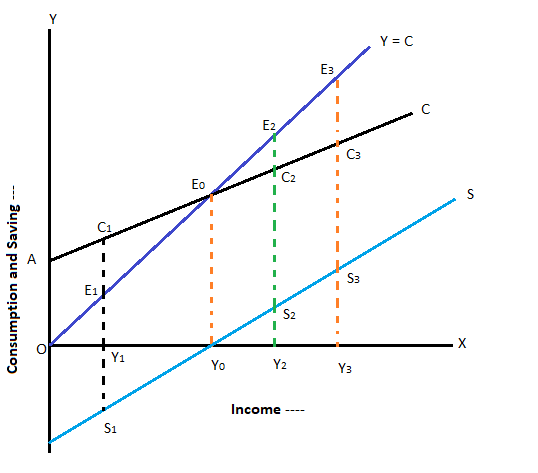Keynes psychological law of consumption states that when income increases, consumption also increases but increasing consumption is less than increasing income and the part of income which is not consume is saved.
Hi friends welcome to my website khanstudy.in, in today’s article we are going to know about Keynes Psychological Law of Consumption (Psychological law of Consumption). So let’s discuss in details.
Table of Contents
Keynes Psychological Law of Consumption
The main basis of consumption function is the psychological law propounded by Keynes. The law implies that there is a tendency on the part of the people to spend on consumption less than the full increment of income.
Assumption of Keynes Psychological Law of Consumption
The Keynes law is based on the following assumption –
(i) This law is based on the assumption that the psychological and institutional complex influencing consumption expenditure remain constant.
(ii) The law is applicable under normal conditions.
(iii) The law operates in a rich capitalized economy, where there is no government intervention.
Propositions of Keynes Psychological Law of Consumption
Let us now the main propositions of the psychological law of consumption, these are explained below –
(a) When income increases, consumption expenditure also increases but by a smaller amount. Symbolically,
ΔC/ΔY < 1 or ΔC < ΔY
(b) As increase in income is divided into some ratio between consumption and saving. It implies that a part of increasing income which is not spent in consumption is saved. Thus, symbolically,
ΔY = ΔC + ΔS
(c) With the increase in income, both consumption spending and saving will either lead to less spending or less saving before. Thus symbolically,
ΔY > 0 then ΔC > 0 and ΔS > 0.
The Keynes psychological law of consumption and the three above mentioned propositions of the law can be understand with the help of following table and diagram –
Table and Diagram of Keynes Psychological Law of Consumption
| Income (Y) | Consumption (C) (in Rs. Crore) | Saving (S) S = Y – C |
| 0 | 20 | – 20 |
| 100 | 110 | – 10 |
| 200 | 200 | 0 |
| 300 | 290 | 10 |
| 400 | 380 | 20 |
| 500 | 470 | 30 |
| 600 | 560 | 40 |
| 700 | 650 | 50 |
In the above table, when income of the community has increased by 300 crore consumption increases by 290 crore and verifying the first propositions which says that when income increases consumption also increases but less than income.
The increases in income by Rs.300 crore is divided in a constant proportion through between consumption and saving, consumption increases by Rs.10 crore with each income increases by Rs.300 crore.
Diagrammatically, it also be explained in the following figure –

It starts not from the origin ‘O’ but from point ‘A’ implying that even when income is zero, consumption is not zero because some basic needs of the people must be satisfied even if the income is zero.
Till point ‘E0‘ as shown in the figure consumption is more than income. The excess consumption expenditure over and above the income level is met up by utilizing previous saving which is called dissaving.
As for example at OY1 (= E1Y1) level of consumption is more than income. The excess of consumption over income is met up by dissaving of the figure S1Y1 (= C1E1). E0 is the break event point of the economy, because at this point consumption equals the level of income.
After this as income increase, consumption will also increase but not at the same part of income which is not consume is saved. In diagram at OY2 (= E2Y2) level of income. Consumption spending C2Y2 (Y2S2) reflects the amount of saving.
Conclusion
So friends, this was the concept of Keynes Psychological Law of Consumption. Hope you get the full details about it and hope you like this article.
If you like this article, share it with your friends and turn on the website Bell icon, so don’t miss any articles in the near future. Because we are bringing you such helpful articles every day. If you have any doubt about this article, you can comment us. Thank You!
Read More Article

